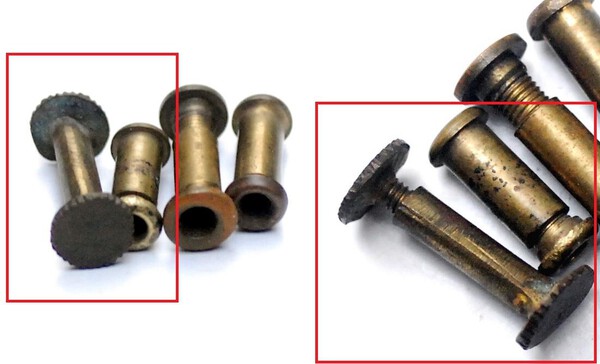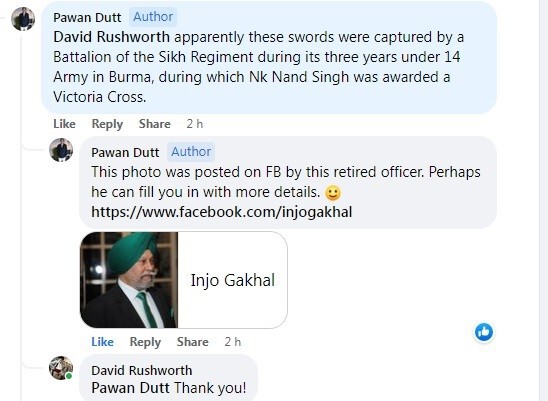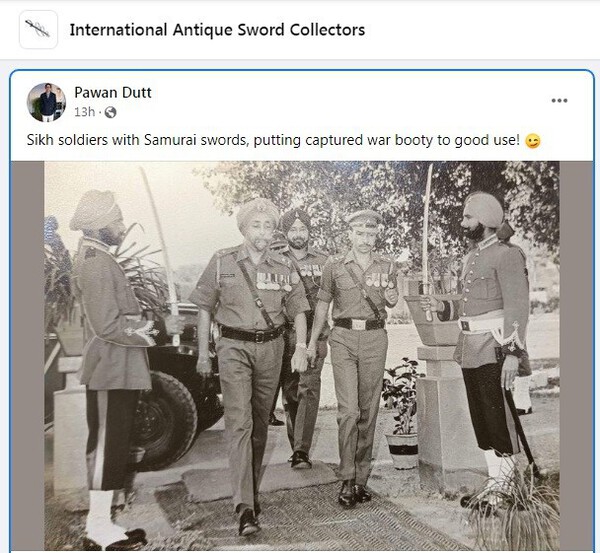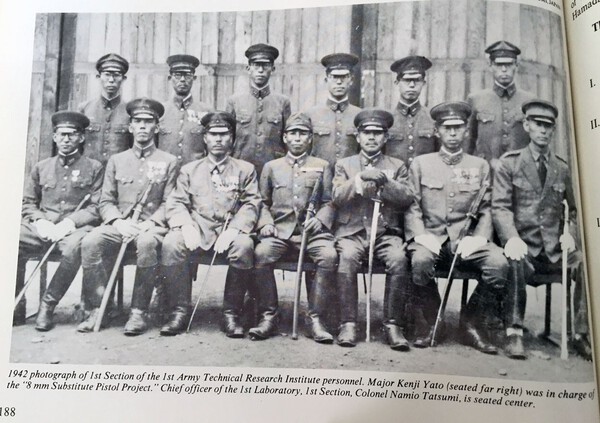-
Posts
1,686 -
Joined
-
Last visited
-
Days Won
12
Content Type
Profiles
Forums
Events
Store
Downloads
Gallery
Posts posted by Dave R
-
-
Turn it around, the blade has a normal distal taper to improve handling with an expanded reinforced point.
-
The pieces of newspaper will be just that, folded bits of random paper used to give a better shape to the binding. I have seen cut wood shavings used for the same job on a WW2 era shin-gunto. The search term to use is hishigami.
The perpendicular marks could be "ashi", breaks in the hamon to stop cracks spreading along the edge, but I reckon they are marks left from random cutting stuff up. A lot happens to a sword in 80 years.
Did you find any stamps anywhere on the tang?
-
I think it's a fake, probably not even Chinese.
-
 1
1
-
-
From what I can see from the photo's it's a fairly typical Seki made late war shin-gunto. The apparent reinforces on the tsuka are more likely paper or wood-shaving shims, glued over the same to protect the ito from the rough nodules of such, which is standard.
Better pics are needed before anything else can be said about it. I cannot see a hamon at all, no apparent stamps, and one of the pics is distorted as though from a copier.
-
I would like to see how it was mounted, personal opinion... a blade was O-suriage until it was an unusable stub, and otherwise went into the armoury as an Okashi-To aka Satsuma blade. I have one just like it.
-
-
Regarding Habaki, when the type 95 was introduced there was a need for a catch up programme because a lot of them were needed all at once. As a result there was a mass conversion of type 32 to type 95. Mr Komiya covers it in some depth on https://www.warrelics.eu/forum/Japanese-militaria/ . How long did the conversion programme last, and was it restarted late in the war. When resources are stretched the habaki is a good candidate for being missed off.
(I have seen a genuine Edo era Satsuma/Okashi To where the habaki was no more than a piece of sheet brass wrapped round the base of the blade.)
-
 2
2
-
-
Personal opinion, I think the date of the blade is a clue here. The bombing campaign had obliterated most of the factories in Japan by this time with the result that production was dispersed to the extreme, and handwork was replacing machine production.
Someone got a very nice (replacement) blade almost by accident, because that was all that was available.
Regarding the polish, another signed and dated gendai field pickup from the Pacific campaign was found to have been finished on a buffer during production in Japan. Desperate times, desperate measures.
-
 1
1
-
-
I am thinking along the lines of Buko-zukuri, to Kyu-Gunto and then Shin-Gunto and finally US occupation. I doubt that the forging down to a screw tang would be done by a bored US Soldier. We have seen similar before.
-
 3
3
-
 1
1
-
-
Nothing wrong with the colour of the saya, I have one the same. According to Mr Komiya over on Japanese Militaria this is a custom order job for an officer with "pretensions" seen more usually pre or early war. This might be a clue as to the other variations seen here. Gunto saya swap over quite easily with Gunto blades in my experience, so this could be a replacement blade.
-
 2
2
-
-
-
-
-
Are you sure it's for a Shin-Gunto. It's a fairly traditional shape and may be a fair bit older.
-
 1
1
-
-
It depends on where you are going to take your collecting, for fun or for investment. I collect for fun, and bought my first Nihonto for peanuts (£4. 10s) well battered, but a much enjoyed piece. I would avoid Ebay nowadays as it is the haunt of deceivers as well as honest sellers. There are swords for sale here, and quite a few pro dealers are on the internet, but basic research is necessary, and for that I recommend the internet. Books are lovely, but expensive the 'net is free. Here on NMB is a good start, but there are many other sites to peruse.
Good hunting!
-
 1
1
-
 1
1
-
-
I would look up David Thatcher... https://yoroi.uk/
-
 1
1
-
 1
1
-
 1
1
-
-
There is a bronze age sword, now in a museum that was collected from a UK farm labourer over a century ago. He was using it as a hedging tool and the collector bought it off him there and then.
Similarly my first Sikkin-Panjang was bought from a local "runner" who had again used it for a while as a hedging tool. I bought a really nice double hammer gun from the same guy. I use the term runner in the sense that he made money by scouring the locality for antiques and curios which he then took to local dealers to sell..... All very "Lovejoy" but that was Shropshire in the 1970's.
-
 3
3
-
-
Context matters, it would help to see the whole sword.
-
 1
1
-
-
I got mine from a high end spectacle shop, any good camera shop or opticians should also be worth a try/
-
 1
1
-
-
-
1 hour ago, Alex A said:
For what its worth, i wont use micro fibre either as i consider it abrasive.
Horses for courses
There is micro fibre, and there is micro fibre. There is the stuff sold in the hardware shop for general cleaning, and then there is the very fine stuff sold for cleaning lenses. Face it guys the lens cleaning fabric is going to be top of the line and the manufacturers won't give a second thought to the possibility that their product is used for cleaning nihonto.....
For the rest, the uchiko v other ways of cleaning convo' has been going on for years on this site.
-
 1
1
-
-
You will see others like it here. Military Swords of Imperial Japan (Guntō)
-
 1
1
-
-
As interest grows, so does the knowledge about wartime blades. It has been proposed before that the Seki stamp was just a quality stamp from the city authorities rather than a condemnation of being non traditional..... Which the Sho stamp seems to have been.
-
 1
1
-
-





![P07-12-16_11.09[1].jpg](https://www.militaria.co.za/nmb/uploads/monthly_2022_06/1370621214_P07-12-16_11_091.thumb.jpg.3729874f4a51ee2c0a48165a1442e5de.jpg)


.thumb.jpg.00cc38465ed187494b701bc730d75ced.jpg)

Type 98? info & opinions please..
in Military Swords of Japan
Posted
A lot of older blades were taken to war, and very few of them were heirlooms. For the most part they were donated by families to the military, or bought from specialist dealers. There are some detailed conversations on this forum about the subject.